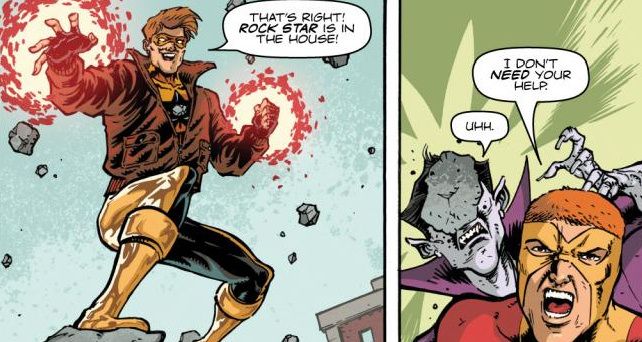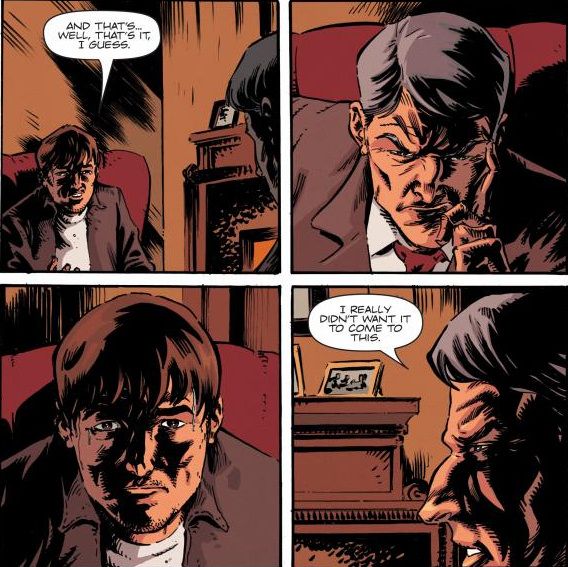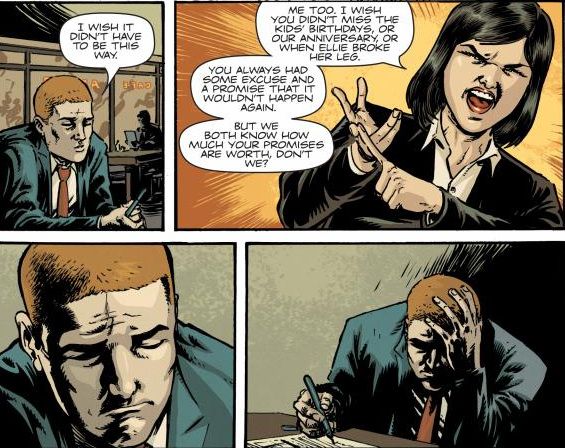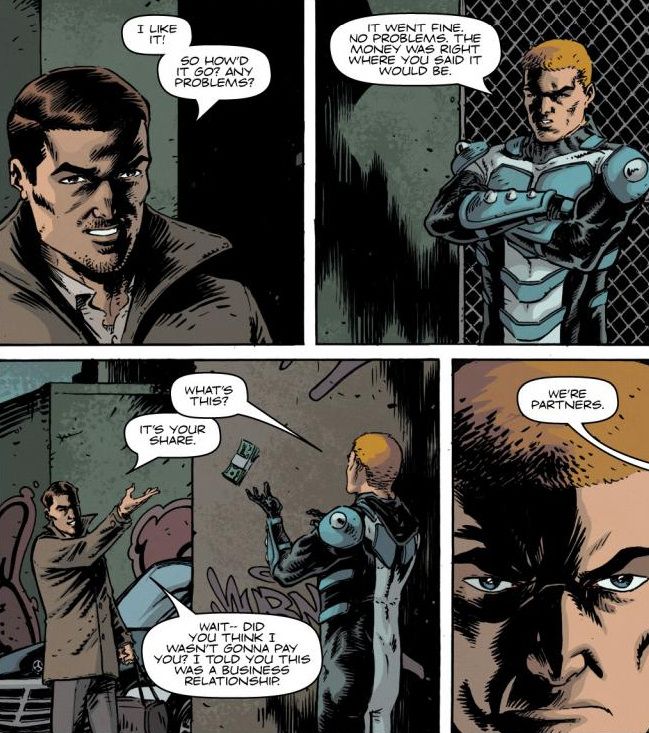"And the shame was on the other side / Oh we can beat them, for ever and ever"
Jay Faerber, whose work in this millennium has been quite excellent, recently fired up a new series at Monkeybrain Comics, which publishes those fancy digital comics that Luddites like me have no truck with. But Faerber was nice enough to send me the first two issues, so I will hand-crank the PC so I can read them and let you know what I think about them. Fair enough?
Faerber writers, Nate Stockman draws, Paul Little colors, and Charles Pritchett letters. The issues cost 99 cents, because that's just how they roll at Monkeybrain.
For your $1.98, you get 24 pages of story (issue #1 is 16 pages, issue #2 is 8, and Faerber says they're going to be 10 pages going forward), so these two issues function basically as a first issue. Faerber writes in his text piece at the back of the first issue (I love text pieces, so I'm glad he's kept them as he's moved to digital) that blending superhero stories and crime stories isn't new, but it's the first time he's done it. Faerber has written two of the best superhero books of the 21st century, and his crime comics are pretty darned good, too, so it's not surprising he tried mixing them, and so far, this is an interesting result. Anti-Hero begins with a bad guy, Callum, who works for a crime boss named Liam (which doesn't seem to fit, somehow, but oh well). Callum has to explain to the boss - Mr. Quinlan sounds better than "Liam," so we'll call him that - why one of their heists went sideways. Callum explains that a superhero - Paragon - showed up and stopped them. Callum tells the story but Stockman shows that he's lying about one thing - he jumped off a bridge because he was scared, not because Paragon threw him, which explains how he didn't get busted - so we establish that Callum is a bit craven, not like your average noble bad guy. Quinlan gives him one more chance to "show him something," and luckily, Callum happens to see Paragon taking off his mask after a long night of heroing. That is, of course, his in.
So that's the hook - Callum blackmails Paragon - Henry - into working with him, because Henry doesn't want his secret to get out.
So far, that means robbing Quinlan, and Callum obviously has plans beyond just getting rich, as he tells Quinlan that he'll track down the mysterious thief (Paragon doesn't wear his superhero costume, obviously), so it's probable he's thinking about a coup. Faerber has quickly set up an interesting and intense situation, something he's become very good at over the past decade or so, and now we have to see how it plays out. While it's a good hook, what's really keen is what Callum (and the reader) discovers when he starts shadowing Paragon. Henry's life is a mess. He has to sign divorce papers served to him by his wife, he won't be able to see his kids as much as he'd like anymore, and his grip on his job is tenuous. All of this stems, of course, from the fact that he often needs to zip off and thwart supervillains, as he needs to do moments after he gets to work. His wife and boss don't know, so of course they think he's a jerk who takes off at inopportune times and takes nothing seriously. One thing Faerber has gotten very good at during his work on Noble Causes and Dynamo 5 is figuring out how superheroes act when they're not superheroing, and he gives us 5 pages in issue #1 that show how Henry's other life has impacted his civilian life. It ought to be a cliché, but Faerber makes it work. The plot of the book is fine, but Faerber is quite good at getting to the heart of his characters quickly and efficiently, so we already have a pretty good handle on both Callum and Henry, which should make the rest of the series (however long it lasts) much more interesting.
Stockman is a decent artist - he's not great yet, but he has a good handle on things, and he gets the job done. There are a few panels with odd renderings - early on, he doesn't quite fit three people into a panel in the way he wants, and it looks a bit odd, perspective-wise - but for the most part, the book looks fine.
He does a nice job with the emotions of the people who are expressing their disappointment with Henry, and in issue #2, when Paragon is interrupted by other heroes who needle him about giving him help, Stockman does a good job showing how the pressure is wearing on the hero. His costume designs are nice and "superheroey," but Little's slightly muted colors help keep the book "realistic," so the book is able to walk the fine line between the gaudy world of superheroes and the "true crime" stuff, which has an entirely different tone. The way Stockman lays the pages out is nice, too - obviously when you're doing small chunks of a comic, space is at a premium, and Stockman makes sure that he gets the information across without the page being too crowded. Even when he wants to "go big" - the first time we see the villain Jack Hammer, for instance, he doesn't take the DC route and give us a full-page splash, but instead simply makes the panel a bit bigger but still small enough to fit more on the page. It gives the book a more European feel (European comics notably use splash pages very rarely), but it also means Stockman uses the space allotted to him very wisely.
There's a lot to like about Anti-Hero - it's kind of hard to get too much of a read on it, because it's so early in the story, but the creative team has done a nice job blending two genres and making it feel like something that would actually happen. One of the reasons Faerber's recent work is so good is because while he puts in some wacky elements, you always get the sense that if superheroes exist, their lives would be like the heroes in Faerber's books rather than in the comics from the Big Two. Anti-Hero is just another example of that, and it's off to a good start. The third issue should be out tomorrow on Comixology, so if you're interested, go check it out.
Rating: ★ ★ ★ ★ ★ ★ ★ ½ ☆ ☆




